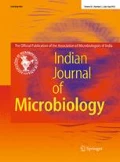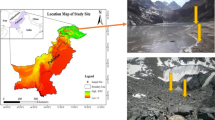Abstract
The Himalayas are water tower for billions of people; however in recent years due to climate change several glaciers of Himalaya are receding or getting extinct which can lead to water scarcity and political tensions. Thus, it requires immediate attention and necessary evaluation of all the environmental parameters which can lead to conservation of Himalayan glaciers. This study is the first attempt to investigate the bacterial diversity from debris-free Changme Khang (CKG) and debris-cover Changme Khangpu (CK) glacier, North Sikkim, India. The abundance of culturable bacteria in CKG glaciers was 1.5 × 104 cells/mL and CK glacier 1.5 × 105 cells/mL. A total of 50 isolates were isolated from both the glacier under aerobic growth condition. The majority of the isolates from both the glaciers were psychrotolerant according to their growth temperature. Optimum growth temperatures of the isolates were between 15 and 20 °C, pH 6–8 and NaCl 0–2%. The phylogenetic studies of 16S RNA gene sequence suggest that, these 21 isolates can be assigned within four phyla/class, i.e., Firmicutes, Beta-proteobacteria, Gamma-proteobacteria and Actinobacteria. The dominant phyla were Firmicutes 71.42% followed by Actinobacteria 14.28%, Alpha-proteobacteria 9.52% and Beta-proteobacteria 4.76%. The isolate Bacillus thuringiensis strain CKG2 showed the highest protease activity (2.24 unit/mL/min). Considering the fast rate at which Himalayan glaciers are melting and availability of limited number of research, there is urgent need to study the microbial communities confined in such environments.




Similar content being viewed by others
References
Byers A (2012) Committee on Himalayan Glaciers, hydrology, climate change, and implications for water security. The National Academies Press, Washington, pp 78–103. https://www.nap.edu/initiative/committee
Jarraud M (2012) WMO statement on the status of the global climate in 2012. In: World meteorological organization, Geneva 2, Switzerland, pp 55–67. https://library.wmo.int/
Petschel G (2007) Mitigation of climate change: contribution of working group III to the fourth assessment report of the Intergovernmental panel on climate change. In: Netherlands environmental assessment agency, Netherland. pp 71–76. https://www.ipcc.ch/pdf/assessment
Gupta C, Prakash DG (2014) Role of microbes in combating global warming. Int J Pharm Sci Lett 4:359–363
Cavicchioli R, Charlton T, Ertan H, Mohd Omar S, Siddiqui KS, Williams TJ (2002) Biotechnological uses of enzymes from psychrophiles. Microb Biotechnol 4:449–460. https://doi.org/10.1111/j.1751-7915.2011.00258.x
Raman KV, Singh L, Dhaked R (2000) Botechnological application of psychrophiles and their habitat to low temperature. J Sci Indian Res 59:87–101
Bottos EM, Vincent WF, Greer CW, Whyte LG (2008) Prokaryotic diversity of arctic ice shelf microbial mats. Environ Microbiol 10:950–966. https://doi.org/10.1111/j.1462-2920.2007.01516
Perreault NN, Andersen DT, Pollard WH, Greer C (2007) Characterization of the prokaryotic diversity in cold saline perennial springs of the Canadian high Arctic. J Appl Environ Microbiol 73:1532–1543
Bowman JP, Rea SM, McCammon SA, McMeekin TA (2000) Diversity and community structure within anoxic sediment from marine salinity meromictic lakes and a coastal meromictic marine basin, Vestfold Hills, Eastern Antarctica. Environ Microbiol 2:227–237. https://doi.org/10.1046/j.1462-2920.2000.00097.x
Liu Y, Yao T, Jiao N, Kang SH (2009) Culturable bacteria in glacial meltwater at 6350 m on the East Rongbuk Glacier, Mount Everest. Extremophiles 13:89–99. https://doi.org/10.1007/s00792-008-0200-8
Hong S, Zhang H, Yang W (2010) Bacteria recovered from a high-altitude, tropical glacier in Venezuelan Andes. World J Microbiol Biotechnol 3:931–941. https://doi.org/10.1007/s11274-013-1511-1
Shen L, Yao T, Xu B, Wang H, Jiao N, Kang S (2012) Variation of culturable bacteria along depth in the East Rongbuk ice core, Mt. Everest. Geosci Front 3:327–334. https://doi.org/10.1016/j.gsf.2011.12.013
Xiang S, Yao T, An L, Xu B (2005) 16S rRNA sequences and differences in bacteria isolated from the Muztag Ata Glacier at increasing depths. Appl Environ Microbiol 71:4619–4627. https://doi.org/10.1007/BF02931042
Xiang SR, Yao TD, An LZ, Xu BQ, Li Z, Wu GJ (2004) Bacterial diversity in malan ice core from the Tibetan Plateau. Folia Microbiology 49:269–275. https://doi.org/10.1007/BF02931042
Zhang X (2003) Diversity of 16S rDNA and environmental factor influencing microorganisms in Malan ice core. Chin Sci Bull 48:1146–1152. https://doi.org/10.1360/02wd0409
Rafiq M, Hayat M, Anesio AM, Jamil SUU, Hassan N, Shah AA, Hasan F (2017) Recovery of metallo-tolerant and antibiotic resistant psychrophilic bacteria from Siachen glacier, Pakistan. PLoS ONE 12:56–61. https://doi.org/10.1371/journal.pone.0178180
Lu M, Fang Y, Li H, Liu WS (2010) Isolation of a novel coldadapted amylase-producing bacterium and study of its enzyme production conditions. Ann Microbiol 60:557–563. https://doi.org/10.1007/s13213-010-0090-8
Zhou MY, Chen XL, Zhao HL, Dang HY, Luan XW, Zhang XY, Zhou BC (2009) Diversity of both the cultivable protease-producing bacteria and their extracellular proteases in the sediments of the South China Sea. Microb Ecol 58:582–590. https://doi.org/10.1360/19301066
Ramakrishna TPM (1988) Self association of a Chymotypsin: effect of amino acids. J Biosci 3:15–22
Tamura K, Dudley J, Nei M, Kumar S (2007) Molecular evolutionary genetics analysis (MEGA) software version 4.0. Mol Biol Evol 24:1580–1596. https://doi.org/10.1093/molbev/msm092
Metsalu T, Vilo J (2015) Clustvis: a web tool for visualizing clustering of multivariate data using Principal Component Analysis and heatmap. Nucleic Acids Res 43:566–570
Lorv JSH, Rose DR, Glick BR (2014) Bacterial ice crystal controlling proteins. Scientifica 3:1–20. https://doi.org/10.1155/2014/976895
Miteva V, Miteva V (2008) Psychrophiles: from biodiversity to biotechnology. Springer, New York, pp 78–99
Rusell N (2000) Towards a molecular understanding of cold activity of enzymes from psychrophiles. Extremophiles 4:83–90
Niehaus F, Bertoldo C, Kahler MA (2000) Extremophiles as a source of novel enzymes for industrial application. Appl Microbiol Biotechnol 51:711–7729. https://doi.org/10.1007/s002530051456
Boetius A, Anesio AM, Deming JW, Mikucki JA, Rapp JZ (2015) Microbial ecology of the cryosphere: sea ice and glacial habitats. Rev Microbiol 13:677–690. https://doi.org/10.1038/nrmicro3522
Yung PT, Shafaat HS, Connon SA, Ponce A (2007) Quantification of viable endospores from a Greenland ice core. FEMS Microb Ecol 59:300–336. https://doi.org/10.1111/j.1574-6941.2006.00218
Acknowledgements
The authors would like to thank the Department of Microbiology, Sikkim University for providing laboratory facilities. Thanks to DST (IUCCC) for providing JRF fellowship to MTS and Forest Department, Govt. of Sikkim for providing research permit and access.
Author information
Authors and Affiliations
Contributions
NT designed the study, reviewed and edited manuscript, MTS did the experimental works, analysis and prepared the manuscript, INN and SD contributed in growth profiling experiments.
Corresponding author
Ethics declarations
Conflict of interest
Authors have no conflict of Interests.
Electronic supplementary material
Below is the link to the electronic supplementary material.
Rights and permissions
About this article
Cite this article
Sherpa, M.T., Najar, I.N., Das, S. et al. Bacterial Diversity in an Alpine Debris-Free and Debris-Cover Accumulation Zone Glacier Ice, North Sikkim, India. Indian J Microbiol 58, 470–478 (2018). https://doi.org/10.1007/s12088-018-0747-8
Received:
Accepted:
Published:
Issue Date:
DOI: https://doi.org/10.1007/s12088-018-0747-8




